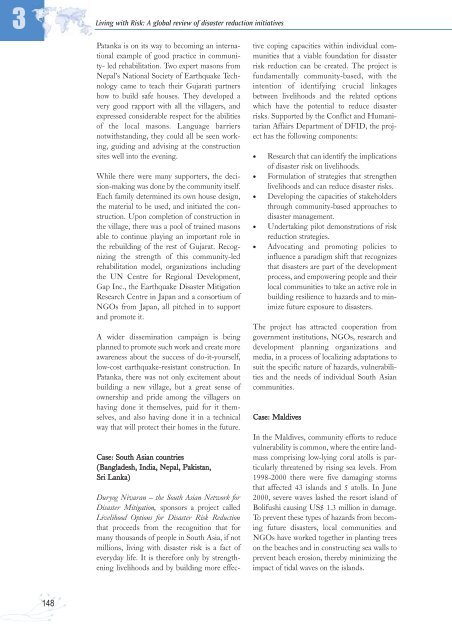A global review of disaster reduction initiatives - Welcome to the ...
A global review of disaster reduction initiatives - Welcome to the ...
A global review of disaster reduction initiatives - Welcome to the ...
Create successful ePaper yourself
Turn your PDF publications into a flip-book with our unique Google optimized e-Paper software.
3Living with Risk: A <strong>global</strong> <strong>review</strong> <strong>of</strong> <strong>disaster</strong> <strong>reduction</strong> <strong>initiatives</strong>Patanka is on its way <strong>to</strong> becoming an internationalexample <strong>of</strong> good practice in community-led rehabilitation. Two expert masons fromNepal’s National Society <strong>of</strong> Earthquake Technologycame <strong>to</strong> teach <strong>the</strong>ir Gujarati partnershow <strong>to</strong> build safe houses. They developed avery good rapport with all <strong>the</strong> villagers, andexpressed considerable respect for <strong>the</strong> abilities<strong>of</strong> <strong>the</strong> local masons. Language barriersnotwithstanding, <strong>the</strong>y could all be seen working,guiding and advising at <strong>the</strong> constructionsites well in<strong>to</strong> <strong>the</strong> evening.While <strong>the</strong>re were many supporters, <strong>the</strong> decision-makingwas done by <strong>the</strong> community itself.Each family determined its own house design,<strong>the</strong> material <strong>to</strong> be used, and initiated <strong>the</strong> construction.Upon completion <strong>of</strong> construction in<strong>the</strong> village, <strong>the</strong>re was a pool <strong>of</strong> trained masonsable <strong>to</strong> continue playing an important role in<strong>the</strong> rebuilding <strong>of</strong> <strong>the</strong> rest <strong>of</strong> Gujarat. Recognizing<strong>the</strong> strength <strong>of</strong> this community-ledrehabilitation model, organizations including<strong>the</strong> UN Centre for Regional Development,Gap Inc., <strong>the</strong> Earthquake Disaster MitigationResearch Centre in Japan and a consortium <strong>of</strong>NGOs from Japan, all pitched in <strong>to</strong> supportand promote it.A wider dissemination campaign is beingplanned <strong>to</strong> promote such work and create moreawareness about <strong>the</strong> success <strong>of</strong> do-it-yourself,low-cost earthquake-resistant construction. InPatanka, <strong>the</strong>re was not only excitement aboutbuilding a new village, but a great sense <strong>of</strong>ownership and pride among <strong>the</strong> villagers onhaving done it <strong>the</strong>mselves, paid for it <strong>the</strong>mselves,and also having done it in a technicalway that will protect <strong>the</strong>ir homes in <strong>the</strong> future.Case: South Asian countries(Bangladesh, India, Nepal, Pakistan,Sri Lanka)Duryog Nivaran – <strong>the</strong> South Asian Network forDisaster Mitigation, sponsors a project calledLivelihood Options for Disaster Risk Reductionthat proceeds from <strong>the</strong> recognition that formany thousands <strong>of</strong> people in South Asia, if notmillions, living with <strong>disaster</strong> risk is a fact <strong>of</strong>everyday life. It is <strong>the</strong>refore only by streng<strong>the</strong>ninglivelihoods and by building more effec-tive coping capacities within individual communitiesthat a viable foundation for <strong>disaster</strong>risk <strong>reduction</strong> can be created. The project isfundamentally community-based, with <strong>the</strong>intention <strong>of</strong> identifying crucial linkagesbetween livelihoods and <strong>the</strong> related optionswhich have <strong>the</strong> potential <strong>to</strong> reduce <strong>disaster</strong>risks. Supported by <strong>the</strong> Conflict and HumanitarianAffairs Department <strong>of</strong> DFID, <strong>the</strong> projecthas <strong>the</strong> following components:• Research that can identify <strong>the</strong> implications<strong>of</strong> <strong>disaster</strong> risk on livelihoods.• Formulation <strong>of</strong> strategies that streng<strong>the</strong>nlivelihoods and can reduce <strong>disaster</strong> risks.• Developing <strong>the</strong> capacities <strong>of</strong> stakeholdersthrough community-based approaches <strong>to</strong><strong>disaster</strong> management.• Undertaking pilot demonstrations <strong>of</strong> risk<strong>reduction</strong> strategies.• Advocating and promoting policies <strong>to</strong>influence a paradigm shift that recognizesthat <strong>disaster</strong>s are part <strong>of</strong> <strong>the</strong> developmentprocess, and empowering people and <strong>the</strong>irlocal communities <strong>to</strong> take an active role inbuilding resilience <strong>to</strong> hazards and <strong>to</strong> minimizefuture exposure <strong>to</strong> <strong>disaster</strong>s.The project has attracted cooperation fromgovernment institutions, NGOs, research anddevelopment planning organizations andmedia, in a process <strong>of</strong> localizing adaptations <strong>to</strong>suit <strong>the</strong> specific nature <strong>of</strong> hazards, vulnerabilitiesand <strong>the</strong> needs <strong>of</strong> individual South Asiancommunities.Case: MaldivesIn <strong>the</strong> Maldives, community efforts <strong>to</strong> reducevulnerability is common, where <strong>the</strong> entire landmasscomprising low-lying coral a<strong>to</strong>lls is particularlythreatened by rising sea levels. From1998-2000 <strong>the</strong>re were five damaging s<strong>to</strong>rmsthat affected 43 islands and 5 a<strong>to</strong>lls. In June2000, severe waves lashed <strong>the</strong> resort island <strong>of</strong>Bolifushi causing US$ 1.3 million in damage.To prevent <strong>the</strong>se types <strong>of</strong> hazards from becomingfuture <strong>disaster</strong>s, local communities andNGOs have worked <strong>to</strong>ge<strong>the</strong>r in planting treeson <strong>the</strong> beaches and in constructing sea walls <strong>to</strong>prevent beach erosion, <strong>the</strong>reby minimizing <strong>the</strong>impact <strong>of</strong> tidal waves on <strong>the</strong> islands.148

















